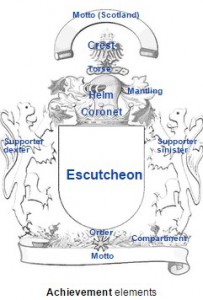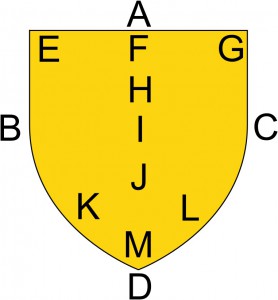When researching a family name, one of the elements that most researchers seek is the family’s “coat of arms.” While the term coat of arms is often used to describe the inherited emblem of a family awarded to ancestors and carried on by descendants, this term only refers to the design on the shield (known as an Escutcheon). The complete display of heraldic components is known as a heraldic achievement.
The first detected use of a heraldic symbol appeared in 1127, when King Henry I of England knighted his son-in-law Geoffrey V, Count of Anjou. Upon knighting Geoffrey V, contemporary accounts record that Henry I placed a shield painted with golden lions on Geoffrey’s neck.[1] In 1484, King Richard III established the College of Arms, which still operates today, to act as an authority in the awarding of arms.[2] In the Middle Ages, heraldic symbols were used to differentiate between individuals within a jurisdiction. Throughout that period and into the modern era, heraldic symbols have continued to represent individuals and their connections to their ancestors.
The components of a complete heraldic achievement include:[3]
- The Escutcheon – the shield, the focal point of the achievement
- The Crest – the symbol on the top of the achievement, usually worn on top of a helmet
- The Torse, or Wreath – sometimes appears as a twisted piece of fabric below the crest
- The Mantling – the drapery tied to the helmet above the shield
- The Helm/Helmet – often varies by rank or social status
- The Coronet – a small crown
- Supporters – small figures often holding upon the shield
- Motto – if possessed by bearer
- Badge – if possessed by bearer
- Order – if possessed by bearer
The shape of the Escutcheon varied by region and over time.[4] On the Escutcheon, there are nine points where symbols (known as charges) could be placed. (See the diagram below for more detail.) For a detailed description regarding the meaning of different charges, visit http://www.fleurdelis.com/meanings.htm
The development and use of heraldic symbols is governed by several important rules which are used to determine the composition of the symbols. Perhaps the most important are the Rules of Tincture. This series of rules prohibits the use of certain color combinations within an achievement. Tinctures are divided into three distinct categories, colors, metals (gold and silver), and furs (patterns).[5] The Rule of Tincture exists largely as a method of differentiating between heraldic symbols to provide visibility and contrast.
Another important feature of coats of arms is cadency: the method of distinguishing between arms belonging to members of the same family. Given that arms are generally inherited, cadency is formed by adding marks of other identifying features.[6] The following is the system utilized for the first nine sons:
- First Son – A label of three points is added to the top of the coat of arms. This label is removed upon the death of the father and the first son inherits his father’s arms of his father (known as a ‘plain coat’).
- Second Son – an upward pointed crescent
- Third Son – a five-pointed star
- Fourth Son – a Martlet (a small bird)
- Fifth Son – an annulet/ring
- Sixth Son – a fleur de lys/lily
- Seventh Son – a rose
- Eighth Son – a Moline/forked cross
- Ninth Son – a double quatrefoil (a design with four lobes, such as a four leaf clover)
Notes
For more information on the history and use of heraldic symbols, see Arthur Charles Fox-Davies' The Art of Heraldry: An Encyclopedia of Armory, available online at https://archive.org/details/artofheraldryenc00foxd.
[1] C.A. Stothard, Monumental Effigies of Great Britain (London: Penguin, 1946).
[2] History, College of Arms, http://www.college-of-arms.gov.uk/about-us/history.
[3] Charles Boutell and Arthur Charles Fox-Davies, The Handbook to English Heraldry (London: Reeves and Turner, 1914).
[4] International Heraldry and Heralds. http://www.internationalheraldry.com/#shield.
[5] International Heraldry and Heralds, http://www.internationalheraldry.com/#tincture.
[6] International Heraldry and Heralds, http://www.internationalheraldry.com/#differencing.
Share this:
About Zachary Garceau
Zachary J. Garceau is a former researcher at the New England Historic Genealogical Society. He joined the research staff after receiving a Master's degree in Historical Studies with a concentration in Public History from the University of Maryland-Baltimore County and a B.A. in history from the University of Rhode Island. He was a member of the Research Services team from 2014 to 2018, and now works as a technical writer. Zachary also works as a freelance writer, specializing in Rhode Island history, sports history, and French Canadian genealogy.View all posts by Zachary Garceau →

